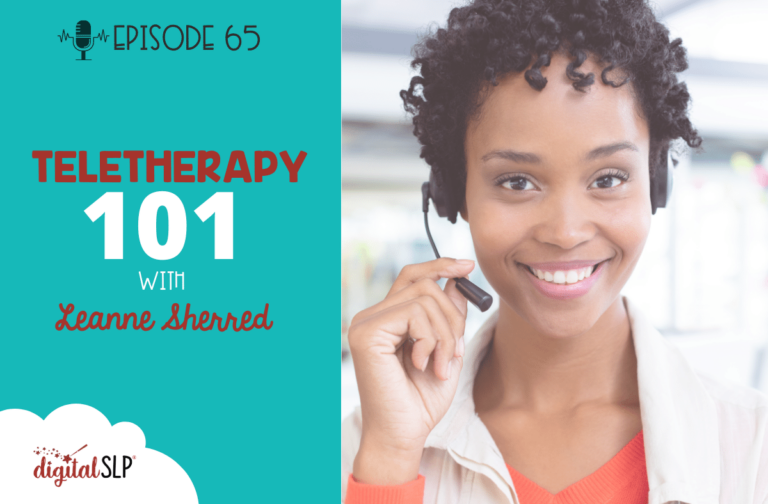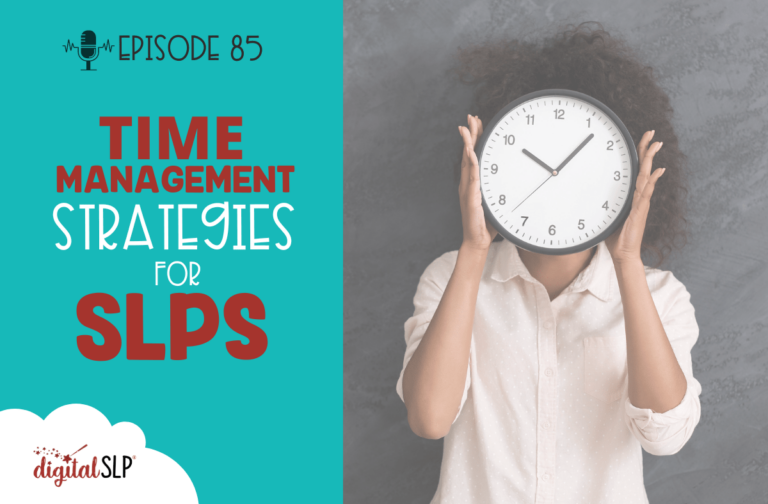Teletherapy and distance learning has been an overnight transition that many SLPs have had to make. To help answer your questions, I had special guest Leanne Sherred come on the show to give you a rundown of some of the basics. If you would like to sign up for the free teletherapy webinar this week, the link to join is bit.ly/teletherapywebinar Tune in below to learn more and be sure to check out the links and resources section at the bottom of the page!
Links & Resources
- Webinar Signup
- The Digital SLP Membership
- Expressable Website
- Q-Global Assessment Platform
- Boom Cards Website
Full Transcript of Podcast: Teletherapy 101
Episode 65: Teletherapy 101
Jessica Cassity: You're listening to the Speech Space Podcast! A podcast full of tips and resources for SLPs. I'm your host, Jessica Cassity, and this is Episode 65. Today, we are going to be talking all about teletherapy. I don't usually post an episode other than on the first and third Tuesdays of the month, but I know that many of you have had questions and I really wanted to be able to give you some answers. So my friend Leanne from Expressable is going to join us in a minute. But before that, I wanted to tell you about something really exciting. I collaborated with a few teletherapy SLPs, and we are going to be doing a live webinar series starting on Wednesday, the 25th and going through Friday the 27th. So it's going to be each night at 7:00 PM Eastern time, we are going to be hopping on live to talk about all things teletherapy, and to answer any of your lingering questions. This is totally free and you can sign up by going to bitly.com/teletherapywebinar. And if you're driving for some reason right now, and you're not able to write that down, I will link to that in the show notes. So you can pull up the show notes later and grab that link. All right, before we get started, I wanted to let you know that this podcast is brought to you by The Digital SLP membership site, which is a site that features time-saving, no print and low prep resources for SLPs. This time of year, the doors are generally closed to The Digital SLP membership. However, due to the fact that many SLPs were reaching out to me in hopes that they could join, I have temporarily opened the doors back up. You can learn more or sign up by going to thedigitalslp.com/digitalslp. All right, let's go ahead and bring Leanne on the show. Hey Leanne, thank you so much for coming on the show today.
Leanne Sherred: Thank you so much for having me!
Jessica Cassity: I'm so excited to talk about all things teletherapy, but before we dive in, can you talk a little bit about who you are and what your experience is with teletherapy?
Leanne Sherred: Absolutely! So, you know, I was one of those people who went straight from undergrad speech right into grad school speech. And the majority of my experience out in the field was with pediatrics. So I've done early intervention and home health and outpatient clinics. And didn't really jump into teletherapy until we kind of pivoted and we're really looking to solve this problem that I felt like I was feeling constantly out working in those different settings, where families I was trying to serve were running into massive speed bumps with insurance companies. And sometimes it really felt like it was at the whim of, you know, the person just deciding they wanted the goal written just the smallest bit differently. And then the family is left submitting all the appeals and time goes by and it's wasted. And so, I really felt like there's gotta be a better way to do this. And so we started Expressable and that's when we really dove into teletherapy and we go direct to the client, direct to the family. We work with adults as well, so we're private pay and we don't go through insurance. And so, I know a lot of the teletherapy field right now is very geared towards schools and contracting with schools. So we kind of are occupying this different space and going direct to the client. And so it's been great ever since teletherapy, you know, I think before getting into it, I might've been a little bit apprehensive. I think starting out like coming out of school, we have all these grand ideas about what therapy has to look like and interpersonal social interactions and all these things. And so part of me might have felt like you, you lose some of that in teletherapy before getting into it, but you really don't, you still form really nice relationships. You can work, you know, social skills are there. It's just like sitting across the table from someone. And so all in all, it's been a great experience with teletherapy.
Jessica Cassity: That's great. That's great. I really, I really liked that. You know, it was something that you developed out of your own struggle to try to solve a problem for other people.
Leanne Sherred: Yeah.
Jessica Cassity: So things are changing right now in the world of teletherapy. You know, as of the last week or two, I feel like everything has really changed. I know a lot of SLPs have questions. A lot of SLPs have concerns, maybe even fears about jumping into the world of teletherapy pretty much overnight. What do you have to say to these SLPs?
Leanne Sherred: I think deep breath is the first part. I absolutely understand their nerves because like I said, before I got into it, I would have apprehension too before trying it out. And so to be kind of forced into making the switch so rapidly, I 100% understand the overwhelmed feeling. If I can help in any way, I would say deep breath and then you've got this. And I mean that in the sense of, you know, we have our clinical skills, we have the experience and we know what we're doing. It's just maybe a matter of making little tiny tweaks. And I hope that people find that those tweaks really can be small to take what you were doing in in-person therapy and transitioning it over to teletherapy. You know, there's all the platforms. I know there's a lot of discussion about what platforms to use. Some therapists are being asked to use specific ones, and there's a lot of conversation going on about HIPAA and FERPA and making sure all of those things are lined up. And that is really tough. I know we're rolling with the punches and I agree that, I kind of feel like we, we definitely shouldn't let those regulations slide. But it's also a very unusual time. So getting past just the roadblock of the platform that you're using, a lot of that, majority of them have at least some kind of screen sharing feature. And so if you have PDF files on your computer, you can screen share them right over to the person and proceed with therapy that way. I know lots of people are being very generous right now about sharing materials that they've created to be used in teletherapy. I'm sure that we're all digging around out there to have all that lined up. Again, I would, it's an unusual time. So, if your teletherapy looks a little bit sloppy, as in, maybe you're holding papers up to the camera instead of sharing the screen, I'm sure that all the families will understand that we're doing our best. We're maybe achieving a lot of the same goals, even if it doesn't look as pretty as it might in in-person therapy, just by the nature of trying to figure it out on the fly. I think that after a couple sessions, hopefully, everyone will find that you can kind of sink into it. You'll slide back into all your clinical skills and knowledge and queuing and everything will kind of hopefully start to feel just as it does when you're in person.
Jessica Cassity: Right. Yeah, that makes sense to give yourself some grace, you know, as you get started, because with anything, I mean, the only way to learn is to get started, right? You have to do it a few times until you start to feel a little bit more comfortable and you learn that, okay, maybe holding the papers up to the screen, isn't going to work as well as sharing a PDF on the screen. You know, I mean, it's not until you do it, that you learned that. So, I think that's a great place to start. You touched on platforms a little bit. Do you have a specific platform that you like or recommend?
Leanne Sherred: So I use SimplePractice and I do really like it. I recommend it. It does not have the capability of letting that person on the other side take control of the screen. I know that that's one that maybe a few platforms out there have, and some teletherapists who have been doing it before this moment, they might prefer that for some of their kiddos who can participate in games that way. But I really find that just this, the screen sharing, is often beneficial enough. My sessions are pretty short, they're 30 minutes. And so I'm someone who doesn't always spend a whole lot of time on, like the extra game side of things, trying to incorporate more as we go, like doing therapy with and keeping it entertaining as we go, rather than taking the breaks and things. But, I know that Zoom has a lot of really great features and that's one that I think that schools have asked people to try out. But as far as I know, I'm not sure if any changes have been made since the crisis has started happening, but the free version of Zoom is not HIPAA compliant, and the HIPAA compliant version has quite a price tag on it for the monthly fee. I know TheraPlatforms is another one that a lot of people enjoy using. There's a lot of great recommendations out there. As far as what I use, we use SimplePractice.
Jessica Cassity: Okay, great. And for those listening about the screen sharing that you were talking about, I think the, well, there's two things I'm gonna say about that. The advantage to that is that your student can click if there's different things, you know, when you turn that screen sharing over, if you're using a PDF file that has clickable elements or, say like Boom Cards or something like that, they can click on that. However, I did talk to an SLP who brought up a good point and, I guess, whatever platform she was using did not have that capability, but she's like, "you know what, I like that it doesn't because then they have to use their language to tell me where to click or what to click." So you're actually kind of getting, you know, you could look at it that way as well. They're getting a little extra practice.
Leanne Sherred: Yeah, definitely, you can. And I know a lot of other ways to not screen, screen sharing like it, teletherapy in itself kind of creates a natural barrier task for following directions, using things like that. You're both maybe drawing a picture on the other side and then showing to see if it matches. So there's a lot of things that kind of come inherent to it and that's a good point. That's another thing.
Jessica Cassity: Yeah. How steep would you say the, if there's somebody listening, who's like, I'm just not tech savvy at all. How steep would you say that learning curve is? I mean, do you think like three, four sessions in you really start to pick it up or do you think it takes a little bit longer?
Leanne Sherred: You know, I think three or four sessions in, I think it's pretty easy to pick up, especially if ahead of time, if you familiarize yourself just a little bit with how the system works. Again, giving ourselves some grace, there's gonna be glitches. Maybe the audio doesn't work on their side, you have to close out the screen, try it again. When that happens, like we always just take it in stride. Usually that's a first session kind of thing and then we smooth it over. It might be, that might happen first session with each family, but once each family has got it down, we smooth it over and then from there, it goes fine. So I think after a few sessions and the main elements that you're using, you know, some of them have a lot of bells and whistles, the platforms, but you definitely can get a handle on the main features that you're using. I think pretty quickly, even if you're not the most, if you wouldn't call yourself the most tech savvy. And if not, and I just encourage you to keep trying and keep exploring it in between sessions and just keep doing your best. I know it feels overwhelming.
Jessica Cassity: Yeah. And I feel like right now it's a good time because there are so many people creating tutorials and blog posts. And so I feel like there's all this additional information. So, you know, I think there's more than usual, in terms of resources that are out there for us to look up and find that kind of help guide us to get started.
Leanne Sherred: Definitely! And, it's amazing kudos to everyone in the SLP community for being so generous of sharing and everything.
Jessica Cassity: Yeah. It's been really amazing to kind of watch it all unfold on social media and, you know, see everybody come together. Let's talk a little bit about the effectiveness of teletherapy versus face-to-face therapy. You wanna talk about that a little bit?
Leanne Sherred: Yeah, absolutely. So, you know, teletherapy, ASHA had it as an improved service delivery model since 2005, but it's definitely the last decades that has seen more people starting to research it more and more to double check its effectiveness. And I think there are some caveats when we're looking at the research. There's not a lot out there quite yet about, you know, working on certain diagnoses and we can guess which ones would be those ones. So AAC, if we have more severe disabilities, if we have a child who has maybe more significant autism where attending to the computer is difficult, or if you have the facilitator on the other side of the screen, whether it's, you know, during school time, if it's a member of the staff or a special education teacher, if it's at home, you know, parent or caregiver, it can be kind of tricky to take maybe our training and help facilitate for them to be able to do the teletherapy effectively with those more significant disabilities. Dysphasia is another one where I think that's still evolving, but as far as a lot of other diagnoses goes -- voice disorders, articulation, phonological, language disorders, social skills, and pragmatics -- the research has shown that teletherapy is often just as efficacious. And a lot of times they do surveys about satisfaction and patient-parent satisfaction is often higher because of, I think, the convenience level that we have playing out there. So if they don't have to drive in traffic for an hour, both ways to get to the therapy clinic, that is just such a bonus that they're happy to jump on with the teletherapy.
Jessica Cassity: Yeah. I was gonna actually ask a little bit about the parents and what kind of feedback you've gotten from parents about the sessions. I mean, is that kind of what you're hearing that they're happy to save on the driving? You know, what else do you hear? What kind of feedback do you hear from them?
Leanne Sherred: Yeah, we hear a lot of feedback about the convenience factor and I think it is huge because in some other cases you might be looking at well, it's just too hard to fit it in, you know speech, it's too hard to get speech therapy done. And so it falls by the wayside, but when you add this convenience factor, because those families, you know, very often they want to get it done. So when you add a convenience factor, really, I think it helps them feel really great about the fact that they are getting it done. And they, a lot of our families love, I think the involvement and getting to be involved. If you're talking about the younger populations, I know there's been a couple of therapists asking, how does it work with those really teeny, tiny tots that early intervention ages, if it's through the computer, don't we not, you know, don't we not want them hanging out on computers and tablets all day long? And I find that the parent coaching and parent education model actually works really well with teletherapy. It's sort of a forcing function for that age group where they have to be the ones to try out those strategies. And then, we're doing, you know, modeling on our side, maybe interacting with the kiddo a little bit here and there modeling with tools that we have on our side of the camera. But then, when it comes time to try it out, the parents are the one trying it, we're supporting them through it. And then they are going to leave that session feeling so ready to continue trying that strategy throughout the entire day. In school age kids and their parents, same thing. You know, parents will very often sit alongside the kiddo in the session to keep them on. Maybe they just were there to keep them on track, but they end up learning all about the cues. We can engage with them a lot more. I usually set up the expectation for, you know, the younger, like kinder, pre-k, six, seven-year old that I really want the parents there with me, no matter what we're working on so that they can stay involved. Once the kids start to get a little bit older, we might, I might give them more autonomy with being the ones who are interfacing the whole time and then just looping the parents back in the way that we might in a typical therapy session, you know. For the most part, the feedback we get is great about the teletherapy. They love being involved, they love the convenience, so yeah.
Jessica Cassity: Yeah, I mean, I love the added involvement piece because I think sometimes that can be such a struggle. You know, not having, especially in the school settings, not always having that communication that you would like with the parents, so to have them there and to kind of have them see the goals that you're working on and some of the strategies that you're using. I can see how that would be really beneficial. Now, what about the kids? So we've talked about some of the perks of teletherapy for the parents, the convenience factor. What about for the kids whenever you're doing teletherapy versus a face-to-face session, what are you finding is kind of like a perk of doing teletherapy for them?
Leanne Sherred: I think most kids these days, they're used to technology. And so they are usually pretty excited to jump on board with it. I think, if they are not, you know, some students and some clients I work with are already maybe doing some kind of online learning. And so they're used to it in that sense, if it's a kiddo who is not used to any kind of online learning, then it's sort of novel and new, and it's fun that it's sort of like this FaceTime, Skype call, but with your teacher and you know, she incorporates all these activities, things like that. So the kids usually take pretty well to it. And they're not, they're not as nervous probably as parents and maybe therapists are to jump in on it, because they're just very familiar with technology. Sometimes the little ones, you know, it goes kinda the same as it does if you're working in person where they have to warm up to you, they might need to warm up to the fact that you're talking to them through a screen. But, you know, I would say that's sort of just the same as in-person, when you meet a kiddo for the first session, they don't know who you are and they've got to spend some time getting to know you. So a lot of aspects feel pretty similar.
Jessica Cassity: Yeah, right, because you have to develop that rapport regardless of whether you're in-person or speaking online. Okay, can we switch gears and talk a little bit about doing assessments online? I know that's something that a lot of SLPs have questions about what that looks like and what do you use and how do you do it?
Leanne Sherred: Yeah. So there are a lot of fantastic resources out there. Q-global and Q-interactive from Pearson are, as far as I've understood from the community as a whole, probably the main way that teletherapists are getting assessments done. Currently, we're using non-standardized assessments. So just because we're private pay, we are using all, you know, we're doing language sampling and analysis, fluency samples, articulation screeners, and building our goals from there. And you know, same with our adult clients as well. There are some therapists who are big fans of document cameras. And so that would be when you have like an external camera that looks down at your page. I would describe it sort of like the overhead screens that we remember from school, where the teacher would write on it. And so some will use those for the stimulus and I think that a lot of, definitely, again, the parent involvement is gonna come into play there. So when you have the older school-age kids, and they're able to respond to some of those stimulus items with the numbers in the corner of the pictures, if it's instead of pointing. But we might also loop in parents for the younger age group if we're double-checking comprehension items. We might rely on the parent to help us determine if that one was, if they pointed to the correct one or the incorrect one. You know, if it's following directions on the self, we can again, kinda double-check with the parents. If we're doing non-standardized measures, we can see through the screen if they followed the direction. So, yeah, there's, I think that it's something that's still kind of evolving and the test makers are probably gonna be getting into it more and more for getting everyone set up with those resources. But I believe the main ones right now are the Q-global. I think it is the big one, yeah.
Jessica Cassity: Okay, great and I'll make sure to link to that in the show notes, in case anybody wants to go and check that out. Let's go ahead and talk about behavior, for a little bit. What if you do have a student who is having a really hard time attending? What are some strategies that you can implement to try to help with behavior management?
Leanne Sherred: So I'm a big fan of visual trackers. I think it's always helpful to have those kids have an understanding of when, when this is going to end, there will be an endpoint. Sometimes they might feel like, you know, again, miss saying that we have the same kind of trouble that we have in person. It's still, it's very valuable for them to know that this is a finite time. We have these goals that we're going to get done. And then, you know, if we're talking about working with a kiddo at home, we, and if they're having behavior trouble, I very often, I'm gonna loop in the parent and talk to them about, okay, let's all talk together about what might be something that we are working for today. What is going to be our reinforcer? And of course, I want to clear it with the parents because I'm not going to offer something that they're not willing for the kiddo to have. I'm not going to offer them a whole piece of cake if parents don't want them to have a whole piece of cake. So looping parents in to talk about what they are working for because, I think, you know, no matter what you might have a kiddo who, in-person or on teletherapy, is kind of that kiddo that needs some kind of encouragement to make it through the work. If they're not quite finding it engaging enough, but I would also encourage staying creative with and staying flexible with swapping tasks. So if they are just not having that goal today, try to switch to the next one, try to see if you can work on something else and find it more engaging for them. Take a break and see if maybe they're interested, especially, I mean, right now, I think we're talking about everyone being at home versus at school. Take a break, maybe they have something around the house that they want to talk to you about, that they want to show you. Do they want to show you their favorite toy? Where is their pet right now? Can they tell you about what their pet looks like? What is it doing? Your favorite snack in the kitchen. So, kind of re-engaging them and giving them a chance to talk about what's in their environment, as opposed to, hey, look at this over here, focus on this screen, kind of letting them settle back into their environment a little bit more. And then, if we're talking about more significant behaviors, of course, then we really will need the "facilitator". And so if it's a family member we'll really work hard to include the coaching and education on their part, that helps them feel confident about jumping in to help out with the behavior and all the strategies that we would use, coaching them through those. So we have our visual cues over here, but they are being coached through helping with those strategies as well.
Jessica Cassity: Okay, great. Do you feel like parents are generally pretty good facilitators or do you feel like you need to provide some sort of training to them prior to, or do you feel like they do a pretty good job kind of jumping in and doing what you need them to do?
Leanne Sherred: Well, I think it depends on the family and I would say, definitely, the training is going to be helpful no matter what. And so sometimes you won't need it, but sometimes, yeah, I think that I'd love to say that parents are always 100% intuitive on what to do, but of course we know that they don't always come to the table with the background knowledge that we come with. So, sharing that setting the expectations upfront, especially if we're jumping in with a kiddo who's not used to teletherapy, they're used to in-person therapy at school or in a clinic, setting the expectations up in that first session that you have together about, you know, this is gonna be different. You know, I won't be there to do all the things that I normally do. So I might need your help to keep us on track. And so here's a reminder about a lot of the strategies that I use and I'll help, you know, I'll let you know when I might need you to help jump in to enact that strategy. So I think that coaching at least upfront a little bit with everyone is good. And then as things arise, providing more and more support. So giving, you know, I like to give some benefit of the doubt at first and just give that little bit of the coaching and then yeah, keep going as if issues arise.
Jessica Cassity: Yeah. I liked the idea of kind of starting with that for everybody and kind of setting the tone and then, you know, if you need to go back in and have some extra training, then you can, but I liked the idea of kind of putting it all out there before you even get started. Yeah. What are some common tech issues that arise and how do you handle them whenever they come up?
Leanne Sherred: I would say the two most common would be the internet connection and then the audio is usually the most common. And like I said, you know, typically those audio issues might come up in the first session, but then as we move forward, we become familiar with the flow, so does the family, and we know how things need to be set up in order for it to be successful. I know that the internet connection, that's something that's really coming up as a barrier right now, because a lot of kids who were trying to do teletherapy with all the sudden, they might not have the best internet connection. And so, you know, that's a challenge. I'm really not, I'm really not sure what everyone is doing about it. As far as the realm of school students goes, we, I think our hearts are breaking and trying to provide for them the best that we can and provide for everyone with a lot of equity. I think every independent school district is looking at what all of this means as far as not only the curriculum, but the additional services. So in our case, when we're getting set up with a family, that's a question that we ask in the consultation is about whether or not the internet connection will be strong enough. And if it's not, you know, that's when we're going to be ethical and upfront and say, you know, telehealth might not be the best option, then let's try to get you, let's try to find a resource for an in-person clinic nearby, or an in-person resource nearby. If, you know, upgrading the internet is not a possibility.
Jessica Cassity: So what is that internet connection that's recommended to kind of optimize the experience?
Leanne Sherred: You know, I actually don't know the exact number. That's a fantastic question. I don't know what the optimal speed is. Maybe, I'd be happy to research it and then send it over for you to include in the info.
Jessica Cassity: Okay, sure. Great, thank you. Let's see, I was going to also ask you if you have any recommendations for like, really neat websites or apps that you can use during your sessions to keep students engaged.
Leanne Sherred: Yeah. Well, I know everyone is talking about being big fans of the Boom Cards right now. Those are awesome. Especially if you have this screen sharing function, where you continue to operate it, that's still engaging. If you have this sharing function where they can take over the mouse, a couple of the cards will have interactive things to do, like in minimal pair discrimination, moving the picture to the right, you know, jar the right location. So the Boom Cards are awesome. I love those. You know, we do a lot of the early intervention stuff, so that focus stays on playing, in the playing in the environment that they're in and not so much with any kind of interactive app or game. And then, yeah, like I said, we, I don't spend a whole lot of our extra time again since we're private pay. So we're trying to get the most, we're trying to get families the biggest bang for their buck. So we don't spend a whole lot of time on it. But as far as the resources go, I use a lot from ReadWorks, for, you know, passage, comprehension and reading stimuli for working on anything with sounds or fluency, things like that. And HomeSpeechHome, if we have a kiddo who has moved off of needing pictures, stimuli, and can just go with the words. Those are some of my most frequent ones that I pull up and have ready to go. But again, yeah, I don't have a whole lot of recommendations on the game side of it. Just since we don't, yeah, we don't spend a whole ton of time on those.
Jessica Cassity: Yeah, no, I like the recommendations for the HomeSpeechHome. I know the word lists there are great. And yeah, Boom Cards are also a really great recommendation. Can you talk a little bit about, I know you talked about how with EI, you're gonna be having them kind of in more of a play environment. Can you talk about the differences of structuring a session for, let's do in three groups? So let's say like EI versus elementary versus kind of older, like middle school, high school. How would you structure those sessions differently?
Leanne Sherred: So I will try to, for EI, I'll try to loop the parent in ahead of time if I have the opportunity to say, or I try to get it set up in one session for the next session, making recommendations about what we might want to have ready to go, what kind of activity we might want to bring in. So then that's really helpful because that helps parents feel prepared. It helps them know what kind of goal we're going to be focused on. Since the biggest part of it is the parent coaching and engagement for the strategies and cues. And that session, you know, if we've picked one activity or two activities, we know what we're going to work on. And same thing there, where the parent coaching model, where you are explaining the strategy, modeling it either with things on your end, or if the kiddo will kind of engage with you across the camera for enough seconds to have to try out a model. And then the parent tries it and we coach them through that. So going through that flow throughout activities as we're talking about some early sound development, same thing, they're coaching the parents on strategies, but maybe we'll pull up a couple of picture cards, or if they have any kind of books that are their favorites, we can practice with that slightly increased amount of structure that way. But looking at school-age kids, again, I love to set up the structure upfront. So visual schedules or just any kind of a schedule so that the kiddo knows what's going on and the parent will know as well. If there's resources that I, you know, want the parent to have, I want that kid to have ahead of time. If we're going to be working on certain pictures, maybe we'll send those over in the document, but if we have the screen sharing and it's the first time they're seeing it, we can pull it up, share the screen. And then if we want them to practice, that's when the session's done, then you can send that over. So either way on that one, and you know, same thing like I said, our sessions are short. So the schedule might look like, you know, the first goal, a break where we maybe talk, you know, chat or talk about something in their house, talk about something going on, again, just keeping language involved as much as possible, and then another activity. And usually, you know, 30 minutes flies by in any setting. And I kind of feel like it flies by pretty fast in teletherapy. So, you know, quick break in the middle, maybe if you have a kiddo, who's able to make it through the whole session and then just, you know, work for that break at the end, structuring it that way. And then the middle school and, you know, high school-age students and clients, I pretty much try to fill that whole 30 minutes with work or conversation, you know, language time. I might give them if they need, if they're a student, a kiddo who needs the visual schedule, we might, we can definitely still do that, but I might just lay it out over belief for them upfront. And then same thing, just working through our goals, one at a time, the way that we would in in-person therapy.
Jessica Cassity: Great. Great. I really like how you broke that down because I think that's going to be helpful for a lot of people, especially those who are having caseloads with that wide age range. So before you wrap up, are there any other tips or pieces of advice that you'd like to give to SLPs who are just getting started with teletherapy?
Leanne Sherred: I think my advice would be kind of the same as in the beginning, just reminding everyone that you've got this and SLPs are, I think, known for being flexible because we have to be flexible in any given session. I think from what I've seen out there, everyone is really stepping up to the plate and ready to jump in feet first on this, even though it feels overwhelming to have to do it overnight. And I think, look at it as adding, you know, a new skill to your toolbox. Now you'll be able to say you have this experience, whether or not you love it and want to continue with it. I think that's important, too. You know, you might not love it. It might not be for you. I know everyone will do their best if that's the circumstance that we're dealing with and everyone's going to bring all their clinical skills to the table, all their creativity, all their patience. And so I think I would recommend just giving yourself a lot of positive affirmations for everything that you do bring to the table. Even if this thing is new and we're on a learning curve, that's pretty steep. You're automatically off on a good foot because of everything that you knew prior to this tough moment.
Jessica Cassity: I love that. And I also like how you said that, you know, this might not be your thing, you know, it doesn't have to work for everyone. You don't have to stick with it forever, but, you know, give it your best, go and be positive about it because this is where we are right now, you know, this is our reality. Right. So, yeah. Okay. Can you tell everyone how they can find you if they want to connect with you?
Leanne Sherred: Yeah, absolutely. They can send any questions or anything to info@expressable.io. I'm happy to answer any questions that I can, if someone has anything else about telepractice. They can check out our website. We have a couple of great blogs up there. Again, that would just be www.expressable.io, and we're on Facebook and Instagram, as a lot of us are, so definitely feel free to reach out.
Jessica Cassity: Okay. Well, thank you so much for coming on the show today and sharing all of your experience and words of wisdom with our listeners.
Leanne Sherred: Yeah. Thank you so much for having me. I hope that people find it helpful.













Recent Comments